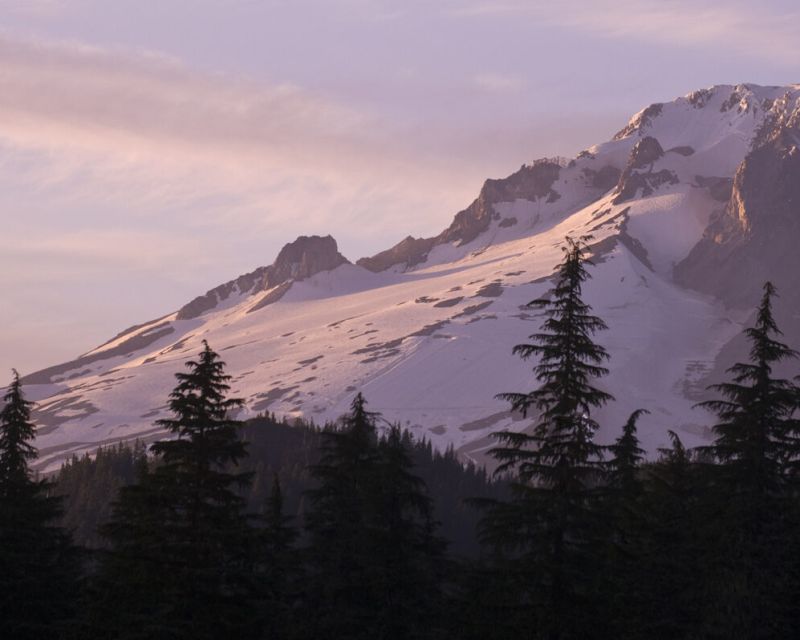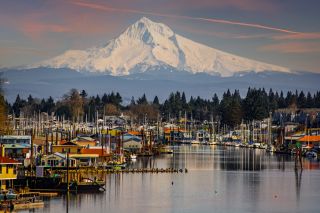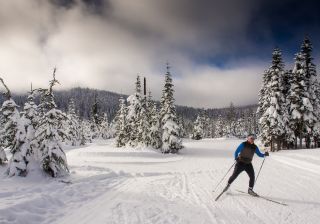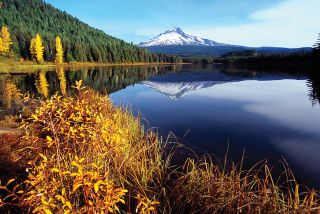What to Do on Mount Hood
Oregon’s tallest peak sits an hour from Portland — and offers year-round outdoor adventure.
Know Before You Go
Before starting your trip to Mount Hood, check the National Weather Service’s website for up-to-date information on current snow conditions and weather advisories that may be in effect. For current travel advisories and road conditions on the route to Mount Hood, visit the Oregon Department of Transportation’s Trip Check website.
Just an hour east of Portland, Mount Hood isn’t just Oregon’s tallest peak; it’s an iconic destination that’s beloved for four seasons of outdoor adventure.
If you’re considering a trip to Mt. Hood, here’s everything you need to know to get inspired and start planning. (Be sure to request a free travel guide from Oregon’s Mt. Hood Territory — teeming with ideas for parks, overnight stays, the area’s best bites and more.)
About Mount Hood
Mount Hood reaches roughly 11,250 feet (3,430 meters) above sea level and, as Oregon’s tallest mountain, has been a source of inspiration, fascination and sustenance since time immemorial.


For generations, members of the Confederated Tribes of Grand Ronde and Confederated Tribes and Bands of the Yakama Nation held religious ceremonies, foraged for huckleberries, traveled and hunted for deer and elk on its forested slopes.
More recently, emigrants on the Oregon Trail traversed Mount Hood’s ridgelines and forests via the Barlow Road, built in 1846 to provide safe passage to Oregon City. In the early 1900s, portions of the toll road were incorporated into the construction of Highway 26.
Is Mount Hood an active volcano?
Mount Hood, part of the broader Cascade Range, has been active for at least 500,000 years. Mount Hood has gone through three major eruptive periods in the past 1,500 to 2,000 years — with the most recent occurring in the late 1700s and early 1800s. Today, Mount Hood shows no sign of imminent eruption and is completely safe for visitors.

Credit: Jon Kraft
Why is it called Mount Hood?
In October 1792, while traveling on the Columbia River, British naval officer William Broughton named the peak in honor of British Admiral Lord Samuel Hood (who never saw the peak himself).
Tips for Visiting Mount Hood
How far is Mount Hood from Portland?
Visitors from Portland, Oregon, have two realistic options for reaching Government Camp, the highest community on Mount Hood and a hub of year-round recreation. Both pass most of Mount Hood’s best-loved attractions — many of which are covered here.
The most direct route measures about 60 miles (97 km) (one-way) and takes about 70–90 minutes via Interstate 84 and Highway 26. A more meandering trip follows Interstate 84 eastbound through the Columbia River Gorge and Highway 35 southbound through the Hood River Valley; from Portland, that 105-mile (170 km) (one-way) trip takes about 2 hours. (Travel times vary due to traffic and weather.)
Both routes comprise portions of the broader Mt. Hood Scenic Byway, which is beloved for its views, cultural attractions and easy access to outdoor attractions.
For car-free travel, consider the Mt. Hood Express, which travels daily between the city of Sandy, east of Portland, and Timberline Lodge on Mt. Hood (with stops at popular resorts and ski areas along the way). Round-trip transportation between ski areas, from Portland and from the Columbia River Gorge, is also available at a few resorts. Learn more about car-free travel to Mount Hood.
Where can you go on Mount Hood?
The first community you’ll encounter east of the Portland region (and along Highway 26) is Sandy, an Old West-inspired city where outfitters provide gear rentals and sales year-round — and where several restaurants offer après- (or pre-) ski fare. Grab breakfast at Joe’s Donut Shop; the old-timey staple has been fortifying skiers since 1974.
Further east are the Villages of Mount Hood, a collection of communities (including Welches, Zig Zag and Rhododendron) with overnight accommodations, groceries and roadhouses serving down-home fare. Where Highway 26 reaches its highest point on Mount Hood (4,000 feet/1,219 m), the town of Government Camp hosts a few outfitters, bars, restaurants and lodging options.
What’s the weather like on Mount Hood?
Government Camp receives about 22 feet (6.7 m) of snow yearly, mostly between November and April. The Mt. Hood ski resorts are higher and receive more snow, of course. If planning a winter visit, wear several layers to stay warm; be sure to pack gloves, a hat and thick socks.
Summers on Mount Hood are mostly sunny — with high temperatures ranging from 60F to 80F (15.6C to 26.7C). If camping, pack a light jacket for brisk summer and fall mornings.
Outdoor Recreation on Mount Hood
There’s plenty to love about Oregon’s tallest peak — no matter the season. Whenever you visit, here are the best things to do on Mount Hood.
Winter Recreation on Mount Hood
In December and January, Mount Hood transforms into a winter wonderland with fresh powder at five ski areas; Timberline Lodge is the highest-elevation resort on Mount Hood (with a season that may last until August), while Mt. Hood Skibowl boasts the United States’ biggest night skiing terrain.

Credit: mthoodterritory.com via Flickr
Cross-country skiers and snowshoers heading to Mount Hood have plenty of backcountry to cover; popular trails include the lollipop-shaped loop around Trillium Lake and nearly 15 miles (24 km) of groomed cross-country skiing trails at Teacup Lake Sno-Park.
If planning a winter visit, stay safe by checking the National Weather Service for updated forecasts and advisories — and TripCheck for traffic webcams, road conditions and key alerts.
Springtime recreation on Mount Hood
Skiers and snowboarders enjoy fresh powder through April at Mt. Hood Meadows, the largest ski area on the mountain. Lower on Mount Hood’s snow-free slopes, avid mountain bikers shred the paths at Sandy Ridge Trail System — home to 17 miles (27 km) of trails for riders of all skill levels — while hikers visit the base of Tamanawas Falls.
Summer recreation on Mount Hood
When the weather warms up, day hikers admire wildflowers in Elk Meadows and bask in the mist of Ramona Falls along the Pacific Crest Trail; backpackers, meanwhile, traverse the 41-mile (66 km) Timberline National Historic Trail, which circles Mount Hood. Paddlers rent kayaks and stand-up paddleboards from Mt. Hood Outfitters and enjoy dramatic peak views from Trillium Lake and Timothy Lake.

Credit: Courtesy of Oregon’s Mt. Hood Territory
Fall recreation on Mount Hood
Hike the kid-friendly, 3.8-mile (6.1 km) (round-trip) Old Salmon River Trail for a sampling of what makes Mount Hood so magical in the fall. Maple trees turn brilliant shades of orange, yellow and red in October — and spawning salmon can be seen beneath the river’s glassy surface. Other opportunities to watch migrating salmon come at Wildwood Recreation Site, where a 0.75-mile (1.2 km) loop trail leads to underwater viewing panels in the Salmon River.
Where to Stay on Mount Hood
Overnight stays on Mount Hood run the gamut from basic campgrounds in stately forests to elegant resorts and lodges around Government Camp. Here are a few favorite stops.


Timberline Lodge, constructed in the 1930s as part of President Franklin D. Roosevelt’s Civilian Conservation Corps program, offers an upscale, alpine-inspired experience that includes a massive stone fireplace in the lobby, impressive views of Mount Hood’s snowy summit, a handful of on-site eateries and a heated outdoor pool and tub. (Fun fact: Timberline Lodge served as the exterior of the Overlook Hotel in Stanley Kubrick’s 1980 film “The Shining.”)
A little further down the mountain, the family-run Huckleberry Inn hosts 16 guest rooms for groups of up to 10.
More than 75 campgrounds are scattered throughout the vast Mt. Hood National Forest, so camping is a popular summertime pastime. A few favorites include Tollgate Campground (where the rushing Zigzag River drowns out noise from nearby Highway 26) and Hoodview Campground at Timothy Lake — where impressive views of Mount Hood await. Most campgrounds offer both first-come, first-served and reservable sites, with reservations available six months in advance through recreation.gov.
Where to Eat on Mount Hood
You’ll find plenty of options to fuel up for the day’s adventure — or to celebrate the memories you made.
In Government Camp, The Ratskeller has specialized in hearty pizza and regional craft beer since 1963. Further down the mountain, several casual eateries and roadhouses dish filling fare — often in the shadow of leafy back patios. Skyway Bar and Grill specializes in barbecue, offering a brisket that’s smoked for 14 hours, and a “Magical Mystery” sauce with a recipe that changes daily. Wraptitude, meanwhile, dishes a mix of filling burgers and wraps — and Pub 26 serves elevated takes on casual bar fare, which never tastes better than on the spacious back patio.
Was this page helpful?
